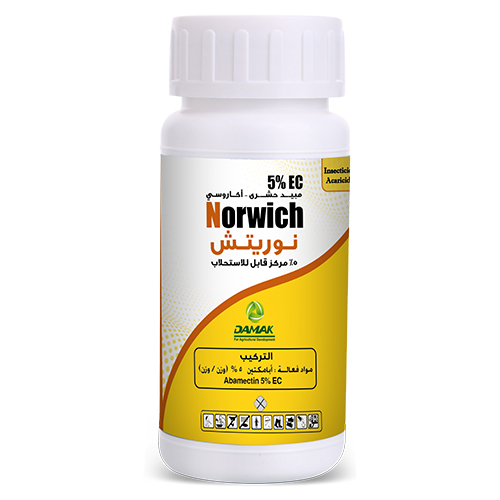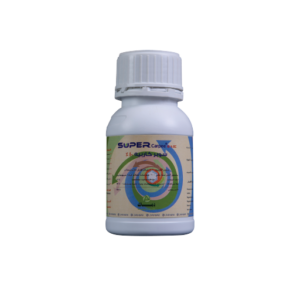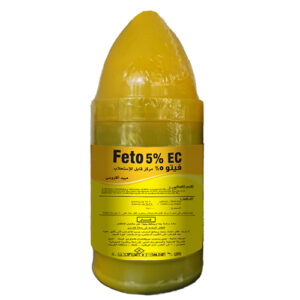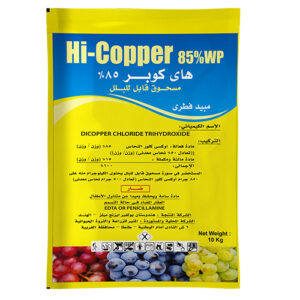– Abamectin is a vital insecticide produced by streptomyces avermitilis which belongs to actinomycetes.
– The pesticide is effective in controlling the red spider, which is one of the most widespread mites on vegetable and fruit crops and causes severe damage to these crops in the form of lack of productivity and low quality of the resulting fruits.
Systemic action of the compound inside the plant:
Systemic pesticide with limited systemic action, it transfers from upper surface to lower surface of plant leaves, and the pesticide forms a pocket inside the parenchyma cells after penetrating the plant leaf tissue, where it persists in these pockets for a long time, making the duration of the effectiveness of the pesticide long against insects and mites.
Mode of action:
Norwich works to inhibit the moving phases of mites parasitizing plants. Abamectin attacks the nervous system of insects, causing their movement to calm down by increasing GABA (Gamma Amino Butyric Acid), in contrast to mites, which causes strong stimulation by increasing glutamic by activating chlorine channels, then the condition is followed by paralysis of the insect or mite within hours and insects and mites do not regain their vitality again, and in general insects and mites stop feeding and moving immediately after application and thus the spread of these pests stops.
Norwich efficacy:
It is an acaridae and insecticide, the effectiveness of abamectin begins as soon as the insect or mite eats it, as it has a stomach action, and it also causes the death of mites and insects by contact, while the pesticide does not affect the eggs, and the insect and mites die within a maximum period of 3 – 4 days, and therefore the peak of its effect on mites and insects is after the third day of application.
Mites and insects that are controlled by Norwich:
Abamectin is a broad-range pesticide that inhibits mites and larvae of leaf miners, whether they are caused by flies or butterflies. The pesticide is effective against sucking insects and beetles on many plant hosts such as citrus, apples, vegetable crops such as potatoes, field crops such as cotton and ornamental plants. When the pesticide falls on the soil, it is decomposed by soil bacteria to produce more toxic compounds against plant pathogenic nematodes.
Diseases that are controlled by Norwich:
According to the recommendations of the pesticides committee of the Ministry of Agriculture and land reclamation.
| Pest | Crop | Concentration |
| Red spider | Tomato | 15 cm3 / 100 L water |
General usage recommendations:
It is a wide spread insecticide against mites, leaf miners, piercing sucking insects, scratching sucking insects and some beetles on vegetable crops as cucurbits, potatoes and fruits as apples , citrus and ornamental plants.
| Crop | Pest (Insect/mite) | Dosage/concentration |
| Citrus | Mites – Leaf miners | 20 cm3 / 100 L water |
| Vegetables | Mites | 80 – 120 cm3 / acre |
| Different crops | Leaf miners | 90 – 180 cm3 / acre |
| Watermelon | Red spider | 15 cm3 / 100 L water |
| Tomatoes – potatoes – soybeans | Red spider | 15 cm3 / 100 L water |
| Cucumber | Red spider | 40 cm3 / 100 L water |
| Sugar beet | Sugar beet fly | 15 cm3 / 100 L water |
| Tomatoes | Leaf miner | 15 cm3 / 100 L water
80 cm3 / acre |
| Different fruit trees
(Grape – Apple – Peach – .. etc) |
Mites | 20 cm3 / 100 L water |
PHI: 5 days.
Maximum residue limits in grapes (MRL): 0.01 mg/kg grape fruit.
Application method: Spraying the vegetative growth with full coverage of the plant.
Product advantages:
Stable product, that doesn’t break down under room temperature conditions for more than two years and doesn’t hydrolyze when (pH 6 – 9) under 25 °C.
Mixability:
Can’t be mixed with highly alkaline solutions (pH more than 9) or highly acidic (pH less than 5).





